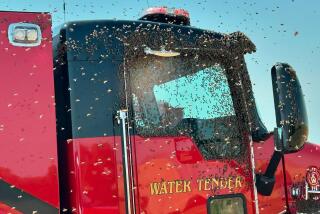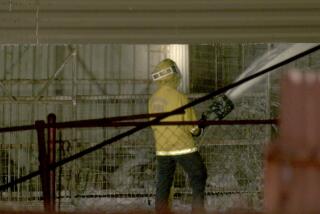Agency Steps Up Efforts to Prepare for ‘Killer Bees’
Preparing for the imminent arrival of the so-called killer bee, Ventura County is forming a swat team to respond to the swarms of calls it expects from residents.
Officials from the agricultural commissioner’s office are set to ask supervisors Tuesday for $40,000 to implement a bee enforcement plan, which includes hiring a private pest control firm to help deal with calls during peak swarming season, from late March to September.
The March 5 discovery of Africanized honeybees in a Calabasas oak tree just east of the county line prompted the local agricultural agency to step up its combat efforts.
“We suspect that we could already be colonized,” Ventura County Deputy Agricultural Commissioner Alan Laird said Friday. “The only thing we don’t have is confirmation. . . . We need the funding to deal with enforcement if we’re going to be the lead bee enforcement agency in the county.”
The plan would also set up a 24-hour toll-free number for people to call with questions and concerns. In addition, it would pay for safety equipment, such as bee suits and sprayers, and would cover the cost of training Sheriff’s Department and Fire Department officials on the proper way to respond to stinging incidents.
Although no more venomous than their European counterparts, Africanized honeybees have developed a reputation as killers because they are easily provoked and attack in swarms.
Although people have died after being stung 100 to 300 times, the average lethal dose for an adult is 500 to 1,000 bee stings, according to experts.
At least five people in the southern United States have been killed by the bees since their arrival in 1990 from Arizona. Last year, a San Bernardino gardener survived after being stung more than 90 times when he hit a hive with a weed cutter.
But some experts say that the fears about the bees are overblown.
“The problem is that over the past 10 or 15 years, the bees have been sensationalized by bad sci-fi movies,” said John Brand, who oversees the Moorpark Vector Control Division. “The fact is, they will become a part of our lives and we’ll have to learn how to live with them.”
Although his agency usually deals with bee calls, Brand will be referring Moorpark residents with Africanized honeybee concerns to county officials.
Supervisor Kathy Long, who sits on the countywide Africanized Honey Bee Task Force, said she will vote in favor of transferring the money from the county’s general fund to the agricultural commissioner’s office.
“It’s obviously a necessary plan and it’s a conservative cost,” Long said. “We have to be prepared for our public safety needs, especially ones that we’re not familiar with.”
Here are steps to take should you be attacked by Africanized honeybees, according to officials at the Los Angeles County West Vector Control District:
* Run away quickly.
* As you are running, pull your shirt over your head to protect your face.
* Do not stop running until you reach shelter, such as a vehicle or building. Do not jump into water. The bees will wait for you to come up for air. If you are trapped for some reason, cover up with blankets, sleeping bags, clothes or whatever else is immediately available.
* Do not flail your arms. Bees are attracted to movement, and crushed bees emit an odor that will attract more bees.
* Once you have reached a shelter or have outrun the bees, remove all stingers. When a honeybee stings, it leaves its stinger in the skin. This kills the bee, but it also means that venom is continuing to enter the wound.
(BEGIN TEXT OF INFOBOX / INFOGRAPHIC)
The danger
The bees are no more harmful individually than the common honeybee, but their agressiveness is legendary. Easily infuriated, they will swarm against a perceived danger, delivering hundreds of stings.
* How far bees will chase:
European bee: Defends up to 450 yards.
Africanized bee: Defends up to half a mile
* Time bees take to anger:
European bee: 19 seconds
Africanized bee: 3 seconds
More to Read
Sign up for Essential California
The most important California stories and recommendations in your inbox every morning.
You may occasionally receive promotional content from the Los Angeles Times.










